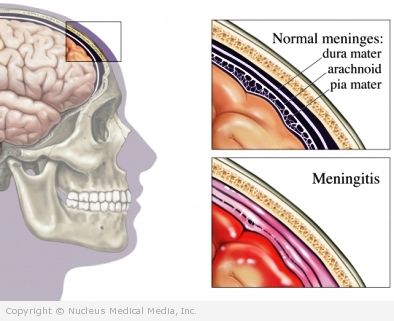Bacterial Meningitis
(Spinal Meningitis)
Bacterial meningitis – Definition
The brain and spinal cord are covered by layers of tissue. These layers are called the meninges. Certain bacteria can cause an infection in these layers. This is called bacterial meningitis.
It is a serious infection that can cause death within hours. Quick diagnosis and treatment is vital.
Bacterial meningitis – Causes
Many times, the bacteria first cause an upper respiratory tract infection. Then, it travels through the blood stream to the brain.
Worldwide, three types of bacteria cause the majority of cases of acute bacterial meningitis:
- Streptococcus pneumoniae (the bacteria that causes pneumonia)
- Neisseria meningitidis
- Haemophilus influenzae b(Hib)
- In the US, widespread immunization has almost eliminated meningitis due to Hib
Other forms of bacterial meningitis include:
- Listeria monocytogenes meningitis
- Escherichia coli meningitis
- Mycobacterium tuberculosis meningitis
- Group B Streptococcus meningitis
Newborn babies and the elderly are more prone to get sick.
Some forms are spread by direct contact with fluid from the mouth or throat of an infected person. This can happen during a kiss or by sharing eating utensils. In general, meningitis is not spread by casual contact.
Bacterial meningitis – Risk Factors
Risk factors for meningitis include:
- Age: infancy and early childhood; increased age
- People in close and prolonged contact with patients with meningitis due to Hib or Neisseria meningitidis
- A weakened immune system due to HIV infection or other conditions
- Alcoholism
- Smoking (for meningitis due to Neisseria meningitidis) and being exposed to second-hand smoke
- Living in close proximity to others, such as in dormitories and military barracks (for meningitis due to Neisseria meningitidis)
- A history of epidural steroid injections or other invasive spinal procedures
Bacterial meningitis – Symptoms
Classic symptoms can develop over several hours or may take one to two days:
- High fever
- Headache
- Very stiff, sore neck
Other symptoms may include:
- Red or purple skin rash
- Bluish skin color
- Nausea
- Vomiting
- Sensitivity to bright lights
- Sleepiness
- Mental confusion
In newborns and infants, symptoms are hard to see. As a result, infants under three months old with a fever are often checked for meningitis. Symptoms in newborns and infants may include:
- Inactivity
- Unexplained high fever or any form of temperature instability, including a low body temperature
- Irritability
- Vomiting
- Jaundice (yellow skin color)
- Feeding poorly or refusing to eat
- Tightness or bulging of soft spots between skull bones
- Difficulty awakening
As the illness progresses, seizures and/or hearing loss can occur. This can happen to patients of all ages.
Bacterial meningitis – Diagnosis
Your doctor will ask about your symptoms and medical history. A physical exam will be done.
Tests may include the following:
- Spinal tap — removal of a small amount of cerebrospinal fluid to check for bacteria
- Other cultures — testing samples of blood, urine, mucous, and/or pus from skin infections
- MRI scan — a test that uses magnetic waves to make pictures of structures inside the body (to be sure the inflammation is not from some other cause, such as a tumor)
- CT scan — a type of x-ray that uses a computer to make pictures of structures inside the body
Bacterial meningitis – Treatment
More than 90% of all people with this infection survive with immediate care, including:
- Antibiotics and corticosteroids — often given together
- Fluids
Talk with your doctor about the best plan for you.
Antibiotics
Antibiotics are given through an IV. This is started as soon as the infection is suspected. The antibiotics may be changed once tests name the exact bacterial cause. Patients usually stay in the hospital until a fever has fallen. The fluid around the spine and the brain must also be clear of infection.
Corticosteroids
These are usually given by IV early in treatment. They control brain pressure and swelling. They also reduce the body’s production of inflammatory substances. This treatment can prevent further damage.
Fluid Replacement
Fluids can be lost due to fever, sweating, or vomiting. They may be replaced through an IV. It will be done carefully to avoid complications of fluid overloading.
Other Medications
- Pain medications and sedatives may be used
- Anticonvulsants may be prescribed to prevent seizures
Bacterial meningitis – Prevention
To help reduce your chances of getting bacterial meningitis, consider the following steps:
- Talk to your doctor to find out which vaccines you and your child need. Examples include:
- Hib vaccine
- Pneumococcal vaccine
- Meningococcal vaccine
- If you are a healthcare worker or have close contact with someone who’s infected, take preventive antibiotics.
- Buy pasteurized milk and milk products. This can prevent meningitis due to Listeria monocytogenes.
- If you are pregnant, your doctor will monitor you to make sure the infection is not passed to your baby.

